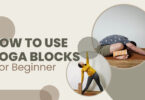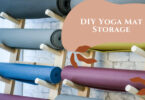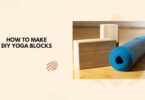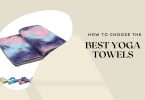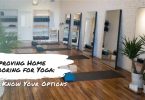If you’re new to yoga, you must wonder why there’s only one piece of equipment, a mat, to perform all yoga poses. Your concern is right, but professionals recommend one other piece of equipment for beginners: a yoga block.
Yoga blocks are props that are used in yoga asana practice to help stabilize the poses. The blocks can allow you to access certain asanas that are sometimes difficult to perform initially. Therefore, it’s a tool to harness the power of yoga irrespective of your body type.
In this article, we’ll learn about the types of yoga blocks, their usage, and their benefits while practicing different poses.

What Is a Yoga Block?
A yoga block is a rectangular-shaped prop made of dense foam, cork, or wood. Its edges are round and have a firm but comfortable density that supports your body while performing asanas. The new practitioners primarily use these blocks to help achieve proper alignment, stability, and support. Furthermore, they come in different sizes. However, the most common dimensions are approximately 9 x 4.5 x 3 inches.
Types of Yoga Blocks
The three most common types of yoga blocks are foam, cork, and wood. Let’s learn about them in the following detail.
1. Foam Yoga Blocks
Yoga blocks made of foam are the primary choice for many beginners due to their lightweight and pressure-handling capability. They are made of dense foam which helps to retain your weight without getting deformed or damaged.
Furthermore, they are softer and squishier which make them ideal for restorative poses as they won’t pressurize the spine and pelvis. Another benefit is that foam blocks are easy to carry around and aren’t slippery.
However, there’s one downside of foam blocks which is their durability. Due to the material, you can’t use them for longer periods as they are prone to get dents and may get torn up from the sides.
2. Cork Yoga Blocks
It’s the most eco-friendly option out of the three, with extended durability and broader usability. Cork yoga blocks are made from Cork Oak tree bark. The cork has natural friction which makes it stick to the surface like an adhesive, letting you stand on the blocks without getting imbalanced or tumbled.
These cork blocks are slightly heavier than foam which make them easier to stack. The sole thing that you may not like about cork blocks is that they are not easy to clean. They have a porous surface which makes the dust to rest on them and hard to wipe off.
3. Wood Yoga Blocks
Wooden blocks are the traditional yoga props that have existed longer than foam and cork blocks. The material that is used for wooden blocks is either bamboo, birch, pine, maple, poplar, or balsa. The sturdy manufacturing options make it the most stable choice to help you do any asana without any risk of falling.
You can use these blocks forever since their material is wood which sometimes lasts longer than humans. But, there are some precautions regarding its use like not placing it on wet or hardwood floors and not stacking them. Since they are slippery on every side, you should place some padding on hardwood floors.
Also, a wood block isn’t ideal for restorative yoga due to its non-squishy properties. If used, it can make your pelvis and spine to be injured. However, a simple padding on the top can help you add some bounce and make it comfortable.
Benefits of Yoga Blocks
A yoga block is designed to push away all the limitations and provide you with benefits like the following:
- Proper alignment: Yoga blocks provide support and height to help you align your body correctly, mainly when you have limited flexibility or strength.
- Improved Flexibility: You can use the yoga blocks to increase the reach of your body while practicing certain poses like fish pose, etc. You can use it as an arm or leg extender to safely and comfortably deepen the stretches.
- Enhanced Stability: You may initially find stabilizing your body difficult. But with a yoga block, you can support your hands, feet, or hips to prevent you from falling or wobbling.
- Core Strengthening: Incorporating yoga blocks can enhance the poses level while performing core activities. You can try balancing between blocks to engage the core muscles more intensely, eventually promoting strength, stability, and control.
- Injury Support: Using a block is necessary if you’re recovering from an injury. During recovery, our muscles get stiff and limit our stretching potential. Therefore, you can use blocks to help you regain that flexibility by letting you stretch your body in small steps. A foam block can also help alleviate the strain on injured or sensitive areas.
- Modification of Asanas: At the start, you’ll feel that some poses are challenging and inaccessible. That’s why most teachers recommend the beginners to use yoga blocks to modify their poses based on their current abilities and gradually progress as they gain strength and flexibility.
How to Use Yoga Blocks
If you’re a beginner, use these tips on how to use the yoga blocks effectively:
- Support in Standing Poses: Standing poses like Trikonasana or Uttanasana can be challenging for beginners. But if you place a yoga block beside your front foot, you can bring the floor closer to your hands. Therefore, it helps you to maintain a proper balance and body alignment.
- Modified Seated Poses: You can use the yoga blocks to sit on them in some poses like Paschimottanasana or Baddha Konasana. The block elevates your hips and helps tilt the pelvis forward, lengthening the spine and facilitating a more comfortable and accessible stretch.
- Balance Poses: Place a block under your hands to help you balance while lifting one leg off the ground while performing such poses like Vrikshasana or Virabhadrasana.
- Chest Opening Poses: Place a block under your sacrum or between your shoulder blades to support the spine and gently open the chest. The block prevents your spine from getting misaligned or experience pain.
- Restorative Poses: While performing Salamba Balasana or Savasana, use a block to support your chest, forehead, chest, or knees. This permits your body to relax and release the tension completely.
Conclusion
A yoga block helps enhance your yoga practice, especially if you’re a beginner. Using the blocks, you will gradually see the difference in the support, stability, and alignment levels. Moreover, consider the factors like material, shape, size, usability, and price while buying a yoga block. Also, if you’re still unsure about the usage, please consult an expert before proceeding.


